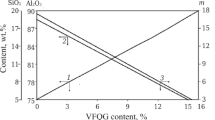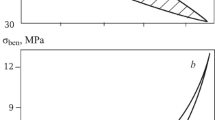Sintering and some properties of fine aluminosilicate ceramic, prepared on the basis of HCBS from broken porcelain electric insulator and pearlite, are studied. After firing at 1000 – 1500°C ceramic has open porosity of 1 – 8%, and ultimate strength in bending and compression of 45 – 65 and 350 – 500 MPa respectively. Compared with traditional fine ceramic materials, such as porcelain, semi-porcelain, hard faience, and majolica, in the new technology comparable properties are achieved with significantly (by a factor of 3 – 5) lower overall shrinkage and a reduced (by 150 – 200°C) firing temperature. Possible areas are indicated for implementingHCBS-technology in the field of production, not only for traditional fine ceramic, but also fine-grained structural, and artistic architectural ceramics.










Similar content being viewed by others
References
I. I. Moroz, T. S. Komskaya, and M. G. Sivchikova, Handbook for Porcelain and Faience Industry, Vol. 1 [in Russian], Legkaya Industriya, Moscow (1976).
I. A. Bulavin, A. I. Avgustinik, A. I. Zhukov, et al., Technology of Porcelain and Faience Manufacture [in Russian], Legkaya Industriya, Moscow (1975).
I. Yu. Guzman (editor), Chemical Technology of Ceramics [in Russian], OOO RIF Stroimaterialy, Moscow (2003).
I. Ya. Guzman, Chemical Technology of Fine Ceramics [in Russian], D. I. Mendeleev MKhTI, Moscow (1985).
P. A. Zemyatchenskii, USSR Clays. General Part [in Russian], Akad. Nauk SSSR, Moscow-Leningrad (1935).
I. Yu. Moreva, “Artificial ceramic binders based on activated materials in fine ceramic technology,” Author’s Abstr. Diss. Cand. Tech. Sci., Belgorod (2008).
E. I. Evtushenko, I. Yu. Moreva, V. A. Doroganov, et al., “Artificial ceramic binder suspensions based on silica-containing materials,” Stroit. Materialy, No. 8, 16 – 17 (2007).
E. I. Evtushenko, I. Yu. Moreva, V. I. Bedina, et al., “Porcelain and faience objects based on two-component binders,” Proc. II seminar-meeting, “Ceramics and refractories: potential solutions and technology,” V. G. Shukov BGTU, Belgorod (2009).
V. P. Barzakovskii and S. K. Dubrova, Physicochemical Properties of High-Voltage Porcelain Glazes [in Russian], Akad. Nauk SSSR, Moscow-Leningrad (1953).
Author information
Authors and Affiliations
Additional information
1Part I of the article was published in Novye Ogneupory, No. 2, 30 – 41 (2013).
Translated from Novye Ogneupory, No. 3, pp. 145 – 154, March, 2013.
Rights and permissions
About this article
Cite this article
Pivinskii, Y.E., Dyakin, P.V., Gorbachev, D.V. et al. Preparation and Some Properties of Sintered Aluminosilicate Ceramic Based on HCBS. Part II1 . Refract Ind Ceram 54, 120–128 (2013). https://doi.org/10.1007/s11148-013-9561-3
Received:
Published:
Issue Date:
DOI: https://doi.org/10.1007/s11148-013-9561-3




